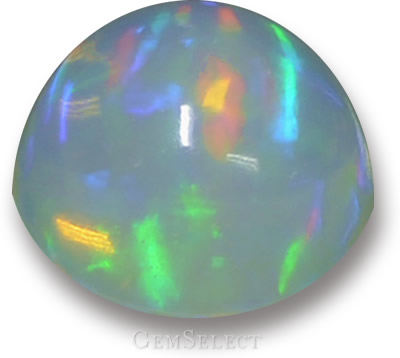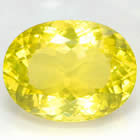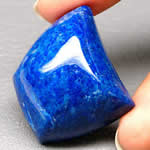Minerals, Rocks and Gems
What is the difference between a mineral, a rock and a gemstone? Are all minerals rocks? Can a rock be a gemstone?

Opal - An Amorphous Gemstone
These are hard questions, but some of them at least have scientific answers. Since there is a science of minerals, called mineralogy, there needs to be a fairly precise definition of what constitutes a mineral. A mineral is defined as a naturally occurring substance that is formed through geological processes and has a characteristic chemical and physical composition, particularly a highly ordered atomic structure that is normally crystalline.
A rock, by comparison, is an aggregate of minerals and need not have a specific chemical composition. Minerals range in composition from pure elements and simple salts to very complex silicates with thousands of known forms. In general, rocks are of three types; igneous, sedimentary and metamorphic. Even though rocks do not have a specific physical composition like minerals, there is a science of rocks as well, called petrology. The study of rocks is essential for understanding the formation of the earth.
 Gemstones have their own science as well, called gemology, which is a branch of mineralogy. But the concept of a gemstone is based on human value judgements. A gemstone is usually defined as a highly attractive and valuable piece of cut and polished mineral that is used in jewelry or other decorations. The science of gemology studies the special physical and optical properties of this subset of the mineral world. Gemstones have their own science as well, called gemology, which is a branch of mineralogy. But the concept of a gemstone is based on human value judgements. A gemstone is usually defined as a highly attractive and valuable piece of cut and polished mineral that is used in jewelry or other decorations. The science of gemology studies the special physical and optical properties of this subset of the mineral world.
However, this definition of a gemstone is not particularly scientific since it does not make much reference to the physical properties of gemstones. Attempts to remedy this shortcoming by referring to the unusual hardness and rarity of gemstones have not been very successful. Some gemstones, such as fluorite, are not especially hard. Also, rarity depends on what is being mined at any given time. Amethyst, the violet variety of quartz, was once quite rare; but today it is fairly abundant.
 To further complicate matters, certain rocks, such as lapis lazuli, are classified as gemstones, since lapis has a long history of use in decoration. Lapis lazuli is composed of several minerals, including sodalite, calcite and pyrite. Certain organic materials, such as amber and coral, are also classified as gemstones, although they have no crystal structure at all, and would not even be described as organic minerals. Actually amber is classified as a mineraloid ('somewhat mineral-like') along with amorphous materials like opal and mercury. To further complicate matters, certain rocks, such as lapis lazuli, are classified as gemstones, since lapis has a long history of use in decoration. Lapis lazuli is composed of several minerals, including sodalite, calcite and pyrite. Certain organic materials, such as amber and coral, are also classified as gemstones, although they have no crystal structure at all, and would not even be described as organic minerals. Actually amber is classified as a mineraloid ('somewhat mineral-like') along with amorphous materials like opal and mercury.
So we can say, by way of an answer, that minerals are crystalline; that rocks are made up of aggregates of minerals; and that gemstones are minerals that humans find especially attractive and valuable (plus a few rocks and organic materials that have found favor). There is a system to it, but the concept of a gemstone, it is fair to say, is a purely human invention.
|
